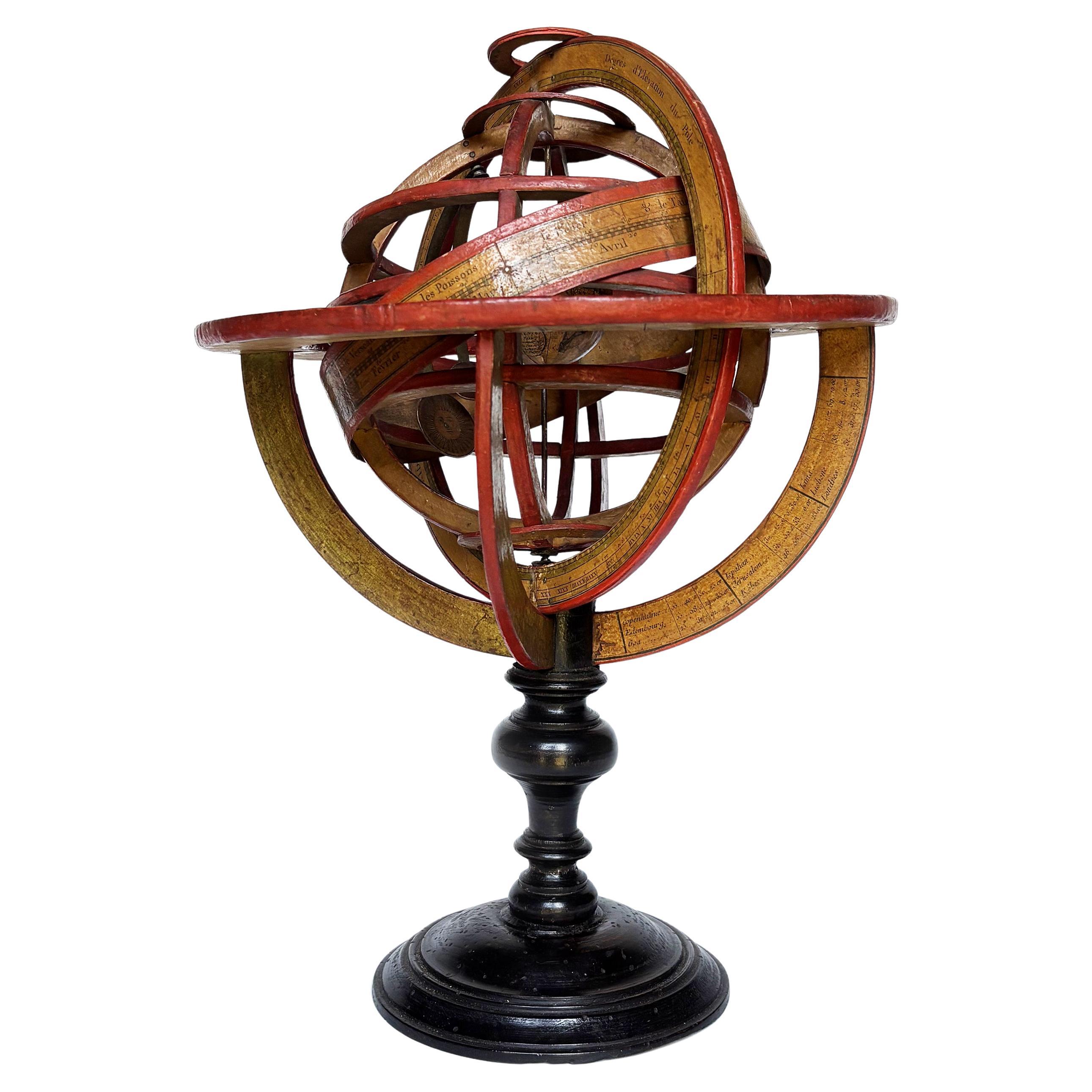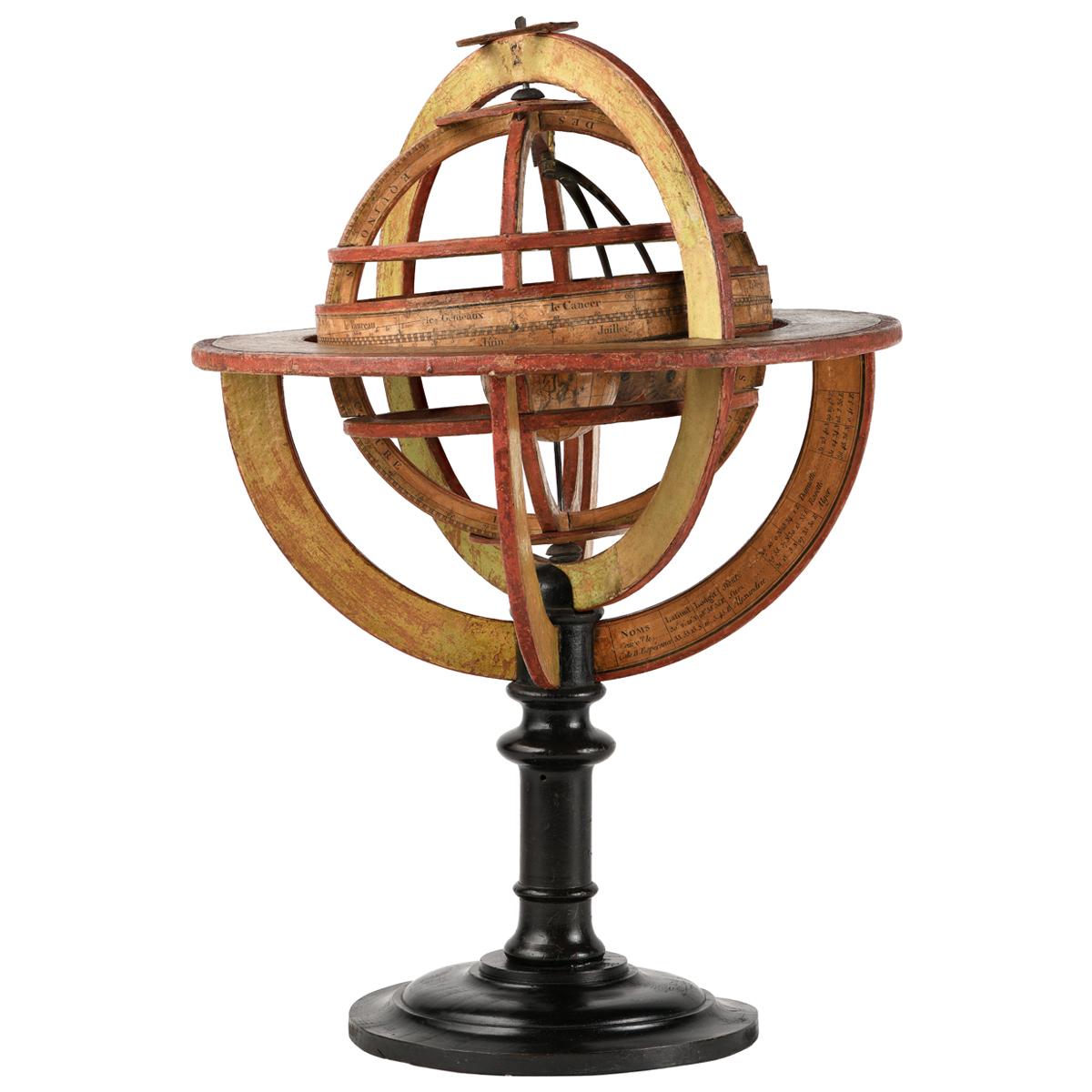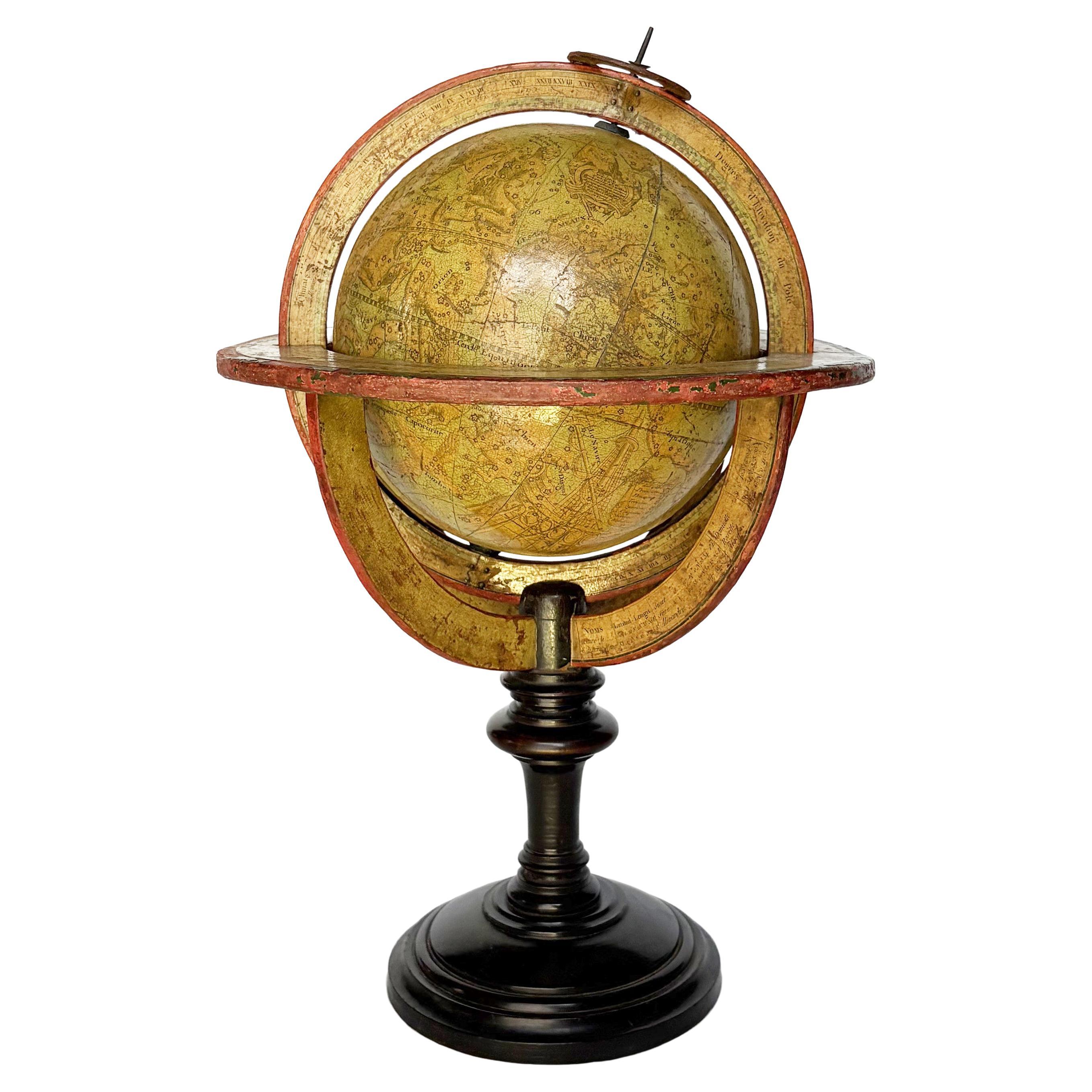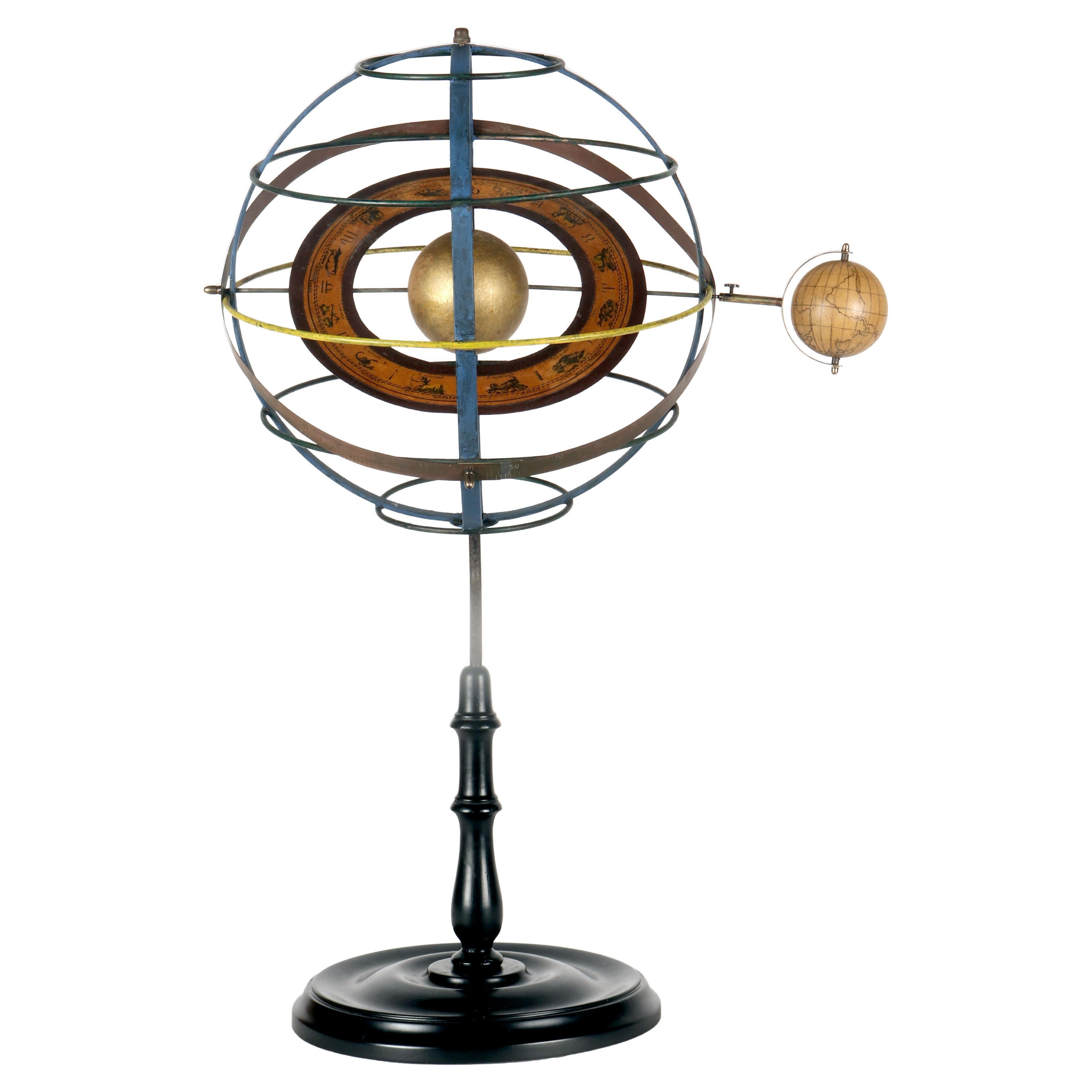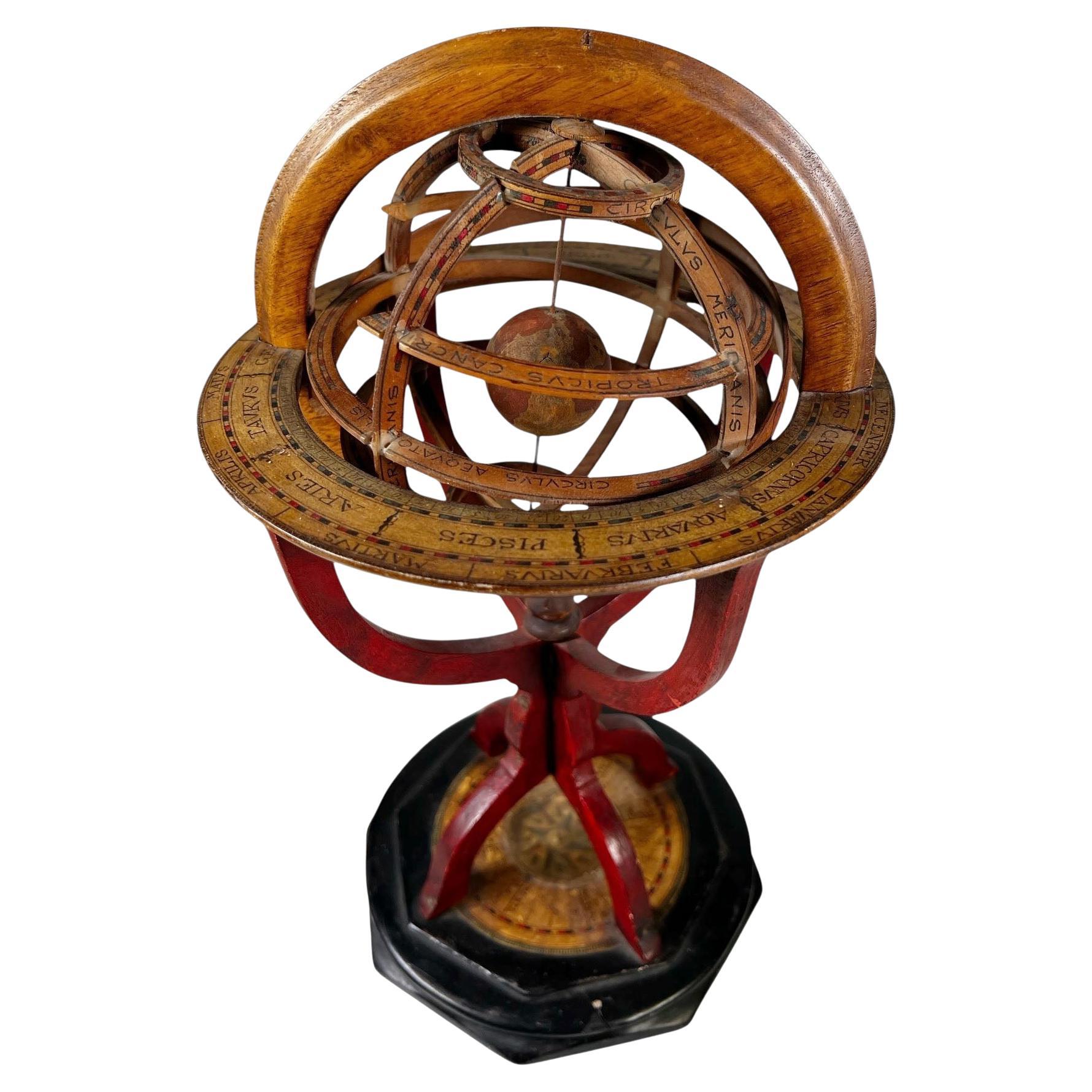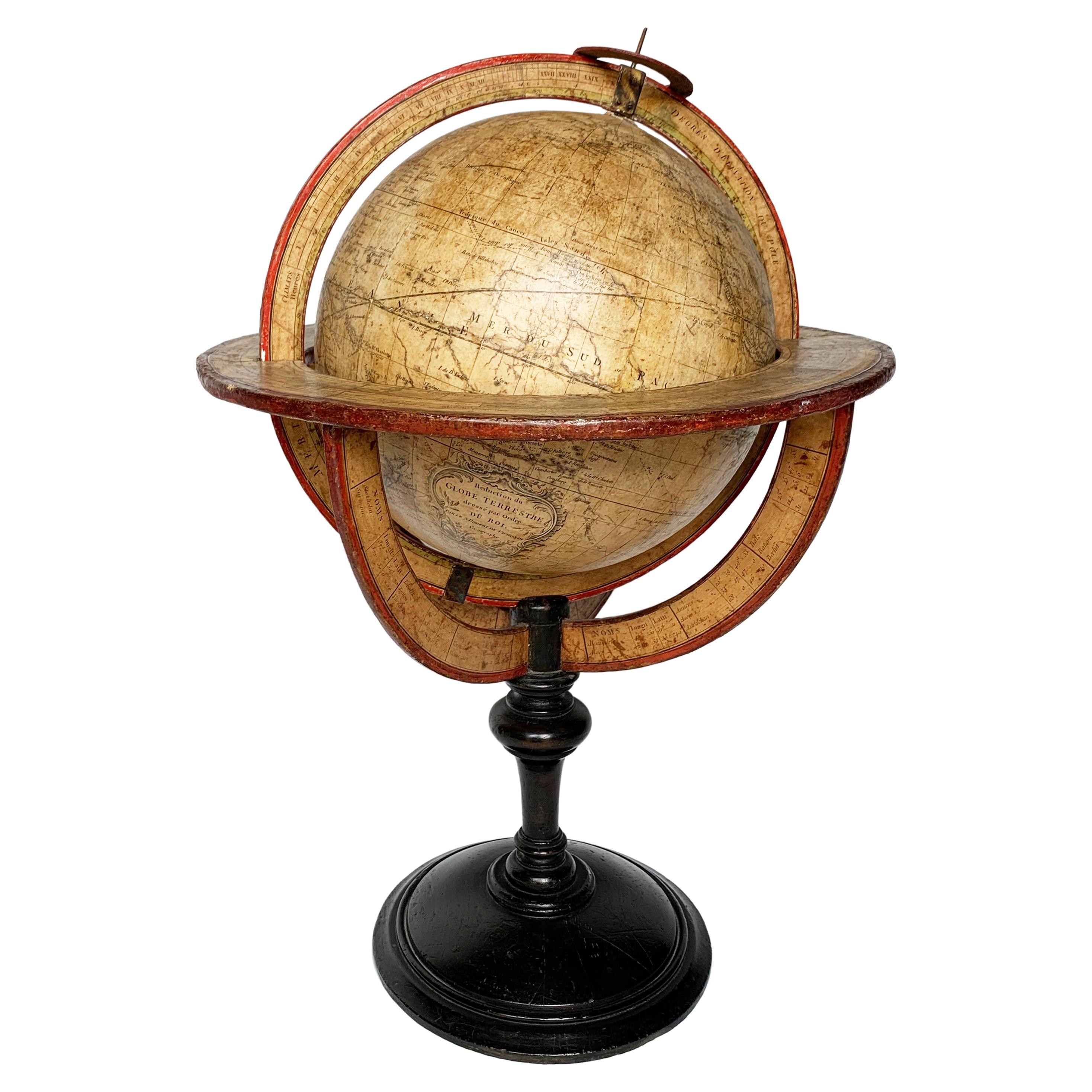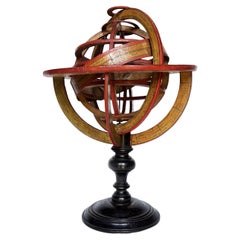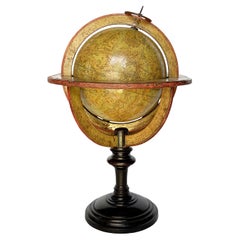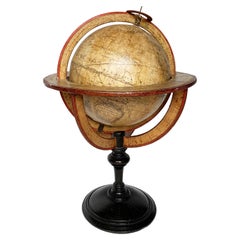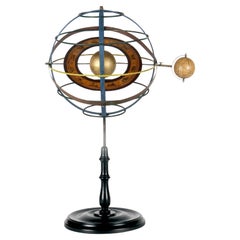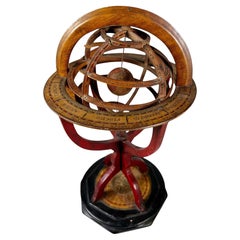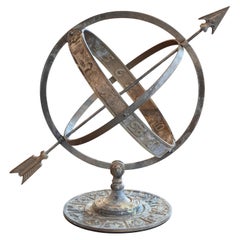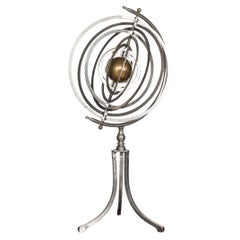Articoli simili a Ptolemaic Armillary Sphere, Charles-François Delamarche, Paris, ante 1798
Vuoi altre immagini o video?
Richiedi altre immagini o video al venditore
1 di 17
Ptolemaic Armillary Sphere, Charles-François Delamarche, Paris, ante 1798
9500 €IVA inclusa
Informazioni sull’articolo
Ptolemaic armillary sphere
Charles-François Delamarche
Paris, ante 1798
Wood and papier-mâché
covered with printed and partly hand-coloured paper
It measures 16.37 in in height x Ø 10.94 in (41.60 cm – Ø 27.80 cm)
It weights 2.33 lb (1.058 g)
State of conservation: consistent with its age and use, the paper shows some signs of use, stains and abrasions.
The sphere is Ptolemaic, with the Earth placed at its centre, surrounded by the Moon and the Sun mounted on two metal arms.
The sphere is composed of six horizontal and two vertical rings (armillae), each bearing graduations and its own name.
The first horizontal ring is illegible. The others, in descending order are: North Pole, Tropic of Cancer, Equator, Tropic of Capricorn, South Pole.
The vertical rings consist of two double meridians.
The sphere is then connected to the large meridian by two pins, a vertical ring inserted perpendicularly into the circle of the Horizon, in turn supported by four semicircles connected to the turned and black-stained wooden base.
Each element is covered with printed paper. It contains various pieces of information: latitudes, length of days, names and zodiac symbols, calendar, wind directions, etc.
The vertical circles mention the latitudes and longitudes of different cities: Rome, Bordeaux, Madrid, Boston, Batavia (Jakarta), Acapulco, etc.
Even the small terrestrial globe is covered with printed paper: continents and oceans appear with numerous geographical markings indicating the most recent explorations.
In the Pacific Ocean, west of South America bears the following inscription:
GLOBE
TERRESTRE
à Paris
chez Delamarche Géog
Rue du Foin Jacques
Au Collège de
M.e Gervais
The North American coasts are well delineated and California appears correctly as a peninsula - reports from Spanish explorers in the region had given rise to confusion as to whether it was connected to the mainland or not. The geographical nature of California was confirmed after the explorations of Juan Bautista de Anza (1774-1776).
Alaska is not described and is only partially traced; it would become part of the United States in 1867.
Various Pacific islands are indicated.
Australia (the name definitely used from 1824) is called "Nouvelle Hollande".
Tasmania is still represented as a peninsula and this is an important detail for the dating of our armillary sphere.
The island is separated from Australia by Bass Strait, which was crossed by Matthew Flinders for the first time in 1798, showing that it was not a peninsula. Delamarche certainly would not have waited a long time to update such an important geographical datum: presumably did so shortly after receiving the news.
Charles-François Delamarche (1740-1817) founded his laboratory around 1770 and, in a few years, he became the most famous French cartographer and globe maker between the 18th and 19th centuries. After having acquired the laboratory of the late Didier Robert de Vaugondy (1723-1786; himself a renowned cartographer who continued the family business founded by his grandfather Nicolas Sanson in the seventeenth century) and after having purchased, between 1788 and around 1800, the businesses of Jean-Baptiste Fortin (1750-1831) and Jean Lattré (around 1750-1800), he began to call himself "Successeur de MM. Sanson and Robert de Vaugondi, Géographes du Roi and de M. Fortin, Ingénieur-mécanicien du Roi pour les globes et les sphères".
Thus, at the end of the eighteenth century, Delamarche possessed the warehouse stocks, as well as the manufacturing skills of the globes of his main rivals in Paris.
In addition to this aggressive acquisition policy, the key to his success also lay in the combination of high-quality cartography combined with extremely attractive globes and armillary spheres; and, of course, its famous red paint finishing touch.
His laboratory was located in Rue de Foin St Jacques "au Collège Me. (or "Mtre") Gervais" in the Latin Quarter of Paris until around 1805, when he moved to rue du Jardinet n. 13.
On the death of Charles-François in 1817, the reins of the company passed to his son Félix (1779-1835), who continued to publish, often in collaboration with the engraver Charles Dien, Senior. In 1835 the company first moved to rue du Jardinet n. 12 and a little later to rue du Battoir n. 7.
Bibliography:
Dekker, Elly, et al. Globes at Greenwich: A Catalogue of the Globes and Armillary Spheres in the National Maritime Museum, Greenwich, London, Oxford University Press and the National Maritime Museum, 1999, pp. 321-322 per la storia dell’impresa dei Delamarche;
Van der Krogt P. e Dekker E., Globes from the Western World, Londra 1993, p. 78;
Van der Krogt P., Old Globes in the Netherlands, Utrecht 1984, pp. 98-99.
- Creatore:Charles Francois Delamarche (Autore)
- Dimensioni:Altezza: 41,6 cm (16,38 in)Diametro: 27,8 cm (10,95 in)
- Stile:Altro (Del periodo)
- Materiali e tecniche:
- Luogo di origine:
- Periodo:1790-1799
- Data di produzione:Circa 1798
- Condizioni:Usura compatibile con l’età e l’utilizzo. Consistent with its age and use, the paper shows some signs of use, stains and abrasions.
- Località del venditore:Milano, IT
- Numero di riferimento:1stDibs: LU4352243704822
Informazioni sul venditore
4,3
Venditore professionale selezionato
Ogni venditore supera rigorosi standard di autenticità e affidabilità
Fondazione nel 1860
Venditore 1stDibs dal 2018
21 vendite su 1stDibs
Associazioni
International Confederation of Art and Antique Dealers' Associations
- SpedizioneRecupero del preventivo…Spedizione da: Milano, Italia
- Politica di reso
Alcune parti di questa pagina sono state tradotte automaticamente. 1stDibs non può garantire che le traduzioni siano corrette. L’inglese è la lingua predefinita del sito.
Garanzia di autenticità
Nell’improbabile caso in cui si verifichi un problema con l’autenticità di un articolo, contattaci entro un anno per ottenere un rimborso completo. DettagliGaranzia di rimborso
Se il tuo articolo non corrisponde alla descrizione, è danneggiato durante il trasporto o non arriva, contattaci entro 7 giorni per un rimborso completo. DettagliAnnullamento entro 24 ore
Hai un periodo di tolleranza di 24 ore per annullare il tuo acquisto, senza necessità di fornire spiegazioni.Venditori professionali selezionati
I nostri venditori di livello internazionale devono aderire a rigorosi standard di servizio e qualità, garantendo l’integrità delle inserzioni.Garanzia miglior prezzo
Se scopri che un venditore ha pubblicato altrove lo stesso articolo a un prezzo più basso, applicheremo lo stesso prezzo.Consegna globale affidabile
La nostra rete di vettori leader del settore offre opzioni di spedizione specializzate in tutto il mondo, inclusa la consegna personalizzata.Altro da questo venditore
Mostra tuttoPtolemaic Armillary Sphere, Charles-François Delamarche, Parigi, ante 1798
Di Charles Francois Delamarche
Ptolemaic armillary sphere
Charles-François Delamarche
Parigi, ante 1798
Wood and papier-mâché
covered with printed and partly hand-coloured paper
It measures 15.55 in in height x Ø ...
Categoria
Di antiquariato/d’epoca, 1790s, French, Altro, Strumenti scientifici
Materiali
Legno, Carta
Sfera armillare tolemaica Charles Charles-François Delamarche Paris, 1805-1810 Circa
Di Charles Francois Delamarche
Charles Charles Delamarche
La sfera armillare tolemaica
Parigi, circa 1805-1810
Wood e cartapesta
ricoperto di carta stampata e in parte colorata a mano
Misura 15,74" di altezza e 11...
Categoria
Di antiquariato/d’epoca, Inizio Ottocento, Francese, Stile impero, Strum...
Materiali
Carta, Legno
Celestial Table Globe, Charles-François Delamarche, Paris, 1791
Di Charles Francois Delamarche
Celestial table globe
Charles-François Delamarche
Paris, 1791
It measures: 17.13 in in height, Ø max 27.7 in; the sphere Ø 7.09 in
(h 43.5 cm x Ø max 27.7 cm; the sphere Ø 18 cm).
W...
Categoria
Di antiquariato/d’epoca, 1790s, French, Altro, Strumenti scientifici
Materiali
Metallo
Globo da tavolo terrestre di Félix Delamarche, Parigi, 1821
Di Félix Delamarche
Globo terrestre da tavolo
Félix Delamarche
Parigi, 1821
Misura 20,47 pollici di altezza, Ø max 14,17 pollici; la sfera Ø 9,44 pollici (h 52 cm x Ø max 36,5 cm; la sfera Ø 24 cm).
...
Categoria
Di antiquariato/d’epoca, Anni 1820, Francese, Restaurazione, Strumenti s...
Materiali
Metallo
Mappamondo tedesco di C. Abel-Klinger, Norimberga, 1860 ca.
Di C. Abel-Klinger
Globo terrestre
Compagnia artistica C. Abel - Klinger
Norimberga, 1860 circa
H. 31 x 22 cm (12,20 x 8,66 pollici); sfera di 14 cm (5,51 pollici) di diametro
lb 2,30 (kg 1,04)
Stato d...
Categoria
Di antiquariato/d’epoca, Anni 1860, Tedesco, Altro, Strumenti scientifici
Materiali
Legno, Carta
Meridiana equatoriale meccanica, Johann Michael Bergauer, Ante 1745
Di Johann Michael Bergauer
Johann Michael Bergauer (Simonsfeld, 1676 - Innsbruck, 1745 circa)
Meridiana equatoriale meccanica
Firmato: Michael Bergauer Insprugg? Innsbruck?
Ante 1745
Ottone dorato e argent...
Categoria
Di antiquariato/d’epoca, Anni 1730, Austriaco, Barocco, Strumenti scient...
Materiali
Ottone
Ti potrebbe interessare anche
Una sfera armillare copernicana, Paravia, Milano, Italia 1930
Una sfera armillare copernicana fatta di ferro, carta, ottone e legno, con il Sole all'interno e la Terra all'esterno, fatta di legno e ricoperta di carta. Piedistallo in legno torni...
Categoria
Metà XX secolo, Italiano, Strumenti scientifici
Materiali
Ottone, Ferro
French Hand Carved Wooden Armillary
A rare and visually captivating French hand carved armillary sphere, dating to around 1900. Crafted entirely of wood and meticulously hand painted, this antique scientific model show...
Categoria
Di antiquariato/d’epoca, Inizio Novecento, Francese, Strumenti scientifici
Materiali
Legno, Pittura
Sfera armillare in bronzo con base Zodiac Con base Zodiac
Sfera armillare in bronzo d'epoca con i classici anelli intrecciati, l'asse della freccia e una dettagliata base circolare ornata da motivi zodiacali. La finitura patinata aggiunge p...
Categoria
Vintage, Anni 1950, Strumenti scientifici
Materiali
Bronzo
Sfera armillare copernicana del XX secolo in acciaio e ottone, 1930 ca.
Sfera armillare copernicana del XX secolo realizzata in acciaio e ottone lucido. Questo strumento illustra il moto celeste del sistema solare, con origini che risalgono all'antica Gr...
Categoria
XX secolo, Europeo, Altro, Strumenti scientifici
Materiali
Ottone, Acciaio
Sfera armillare
Questa sfera armillare è realizzata in metallo e ha una finitura color ruggine. È montato su una piccola piazza di cemento. Come pezzo di conversazi...
Categoria
Inizio XX secolo, Europeo, Soprammobili
Materiali
Calcestruzzo, Metallo
1526 €
Raro globo nautico inglese con sfera armillare (1930) XX secolo
Raro globo nautico inglese con sfera armillare (1930) XX secolo
Buono stato
magnifico mappamondo, con globo terrestre interno in legno rivestito in pelle, nomi dei continenti e deg...
Categoria
Inizio XX secolo, Inglese, Moderno, Oggetti nautici
Materiali
Metallo
1200 € Prezzo promozionale
20% in meno
